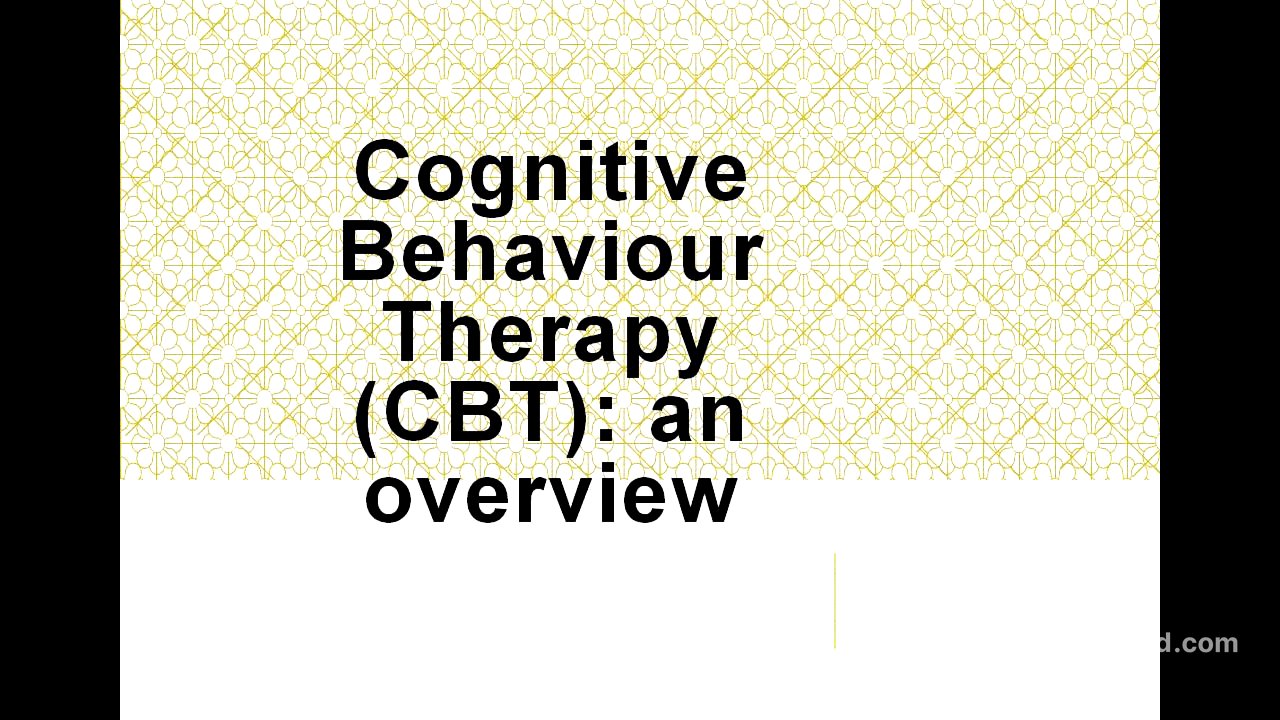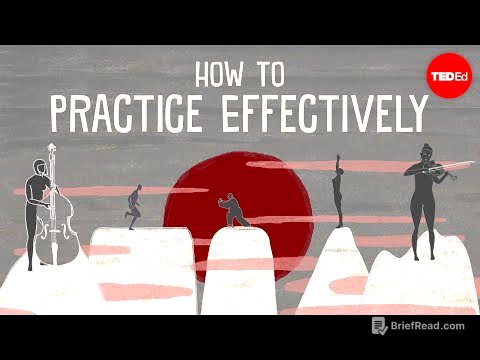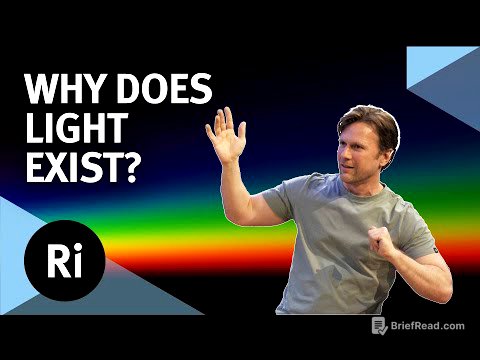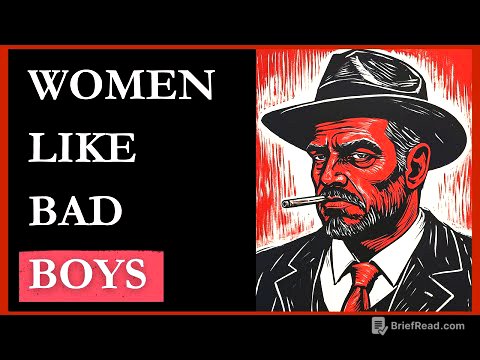TLDR;
This lecture provides a detailed overview of Cognitive Behavior Therapy (CBT), including its rationale, historical development, and practical applications, particularly in treating depression and anxiety disorders. It explains key CBT concepts, techniques, and their differences from exploratory psychotherapy.
- CBT is a time-limited, goal-oriented therapy focusing on present issues.
- Aaron Beck is considered the pioneer of CBT.
- Key techniques include cognitive restructuring, behavioral strategies, relaxation exercises and exposure and response prevention.
Introduction to Cognitive Behavior Therapy [0:02]
The lecture introduces Cognitive Behavior Therapy (CBT), defining it as a psychotherapy that addresses the interplay between thoughts (cognitions) and actions (behavior) to influence mood. The presentation will cover the rationale and history of CBT, its application in treating depression and anxiety disorders, and conclude with a quiz.
Rationale and History of CBT [0:16]
The rationale behind CBT is that negative cognitions and maladaptive behaviors can lead to a depressed mood. By identifying and correcting these negative thoughts and behaviors, one's mood can be improved. Aaron Beck, a professor of Psychiatry at the University of Pennsylvania, is credited as the pioneer of CBT. He initially developed cognitive therapy for depression, which was later expanded to include behavioral components. CBT has since been successfully applied to treat various disorders, often in combination with medication.
CBT in Clinical Practice [4:10]
CBT is typically a time-limited therapy, consisting of 12 to 16 weekly sessions lasting about 50 minutes each. Treatment goals are established at the beginning, and progress is regularly monitored. Patients actively participate and are assigned homework tasks between sessions. Rating scales are used to assess the therapy's effectiveness. CBT focuses on the present rather than the origin of the problem, aiming to equip patients with practical cognitive and behavioral strategies to overcome their difficulties.
Differences Between CBT and Exploratory Psychotherapy [6:34]
This section highlights the differences between CBT and exploratory psychotherapies like psychoanalysis and psychodynamic psychotherapy. The initial assessment in CBT involves describing current difficulties, setting realistic treatment goals, explaining the treatment rationale, and ensuring the patient's willingness to work within the CBT model. Each session should have a clear structure, including reviewing progress, discussing specific problems, devising strategies, assigning homework, and ensuring patient understanding.
CBT for Depression [8:57]
In treating depression, CBT aims to overcome negative cognitions and unhelpful behaviors that maintain the depression. Examples of negative cognitions include feelings of worthlessness or blame, while unhelpful behaviors include social withdrawal and inactivity. Key terms in CBT for depression include dysfunctional assumptions, negative automatic thoughts, and cognitive distortions.
Dysfunctional Assumptions, Negative Automatic Thoughts, and Cognitive Distortions [9:42]
Dysfunctional assumptions are extreme and inflexible beliefs about oneself and the world, often stemming from early life experiences. These assumptions remain latent until a stressful event triggers negative automatic thoughts, which are negative thoughts that pop into one's mind. Cognitive distortions are errors in thinking that maintain depression, and CBT aims to identify and correct these distortions through cognitive restructuring.
Types of Cognitive Distortions [12:00]
The lecture outlines several types of cognitive distortions:
- All-or-Nothing Thinking: Thinking in absolutes (e.g., "always," "never").
- Jumping to Conclusions: Drawing negative conclusions without sufficient evidence, including mind-reading and fortune-telling.
- Magnification and Minimization: Exaggerating mistakes while downplaying achievements.
- Overgeneralization: Making broad generalizations from isolated incidents.
- Disqualifying the Positive: Dismissing one's good attributes.
CBT Techniques for Depression [16:50]
CBT techniques for depression include cognitive strategies like identifying and challenging negative automatic thoughts, and distraction techniques. Behavioral strategies include monitoring activities, scheduling activities for mastery and pleasure, and graded task assignment.
Identifying and Challenging Negative Automatic Thoughts [17:27]
To identify negative automatic thoughts, patients record negative thoughts that arise, focusing on themes related to oneself, the world, and the future. Once identified, patients challenge these thoughts to assess their validity. This process helps patients recognize the link between low mood and negative thoughts, and how challenging these thoughts can improve mood.
Distraction Techniques [20:06]
Distraction techniques are useful for managing acute distress from depression or anxiety. Examples include focusing on an object, doing mental exercises, thinking about pleasant memories or fantasies, sensory awareness, and engaging in absorbing activities.
Behavioral Strategies: Monitoring and Scheduling Activities [23:46]
Behavioral strategies include monitoring daily activities and rating them based on mastery and pleasure. This helps counter negative thoughts about inactivity or lack of enjoyment. Scheduling activities involves planning each day in advance to provide a sense of control and avoid decision fatigue.
Graded Task Assignment [26:43]
Graded task assignment involves breaking down tasks into smaller, manageable steps to overcome procrastination and negative cognitions.
CBT for Anxiety Disorders [27:25]
CBT is effective for various anxiety disorders, including panic disorder, phobias, obsessive-compulsive disorder (OCD), and generalized anxiety disorder (GAD). Panic disorder involves episodic anxiety attacks with cognitive and physical symptoms. Phobias involve anxiety triggered by specific stimuli.
Panic Disorder and Phobias [28:04]
Panic disorder is characterized by sudden, unexpected anxiety attacks accompanied by both cognitive (e.g., fear of dying) and physical symptoms (e.g., palpitations). Phobias, on the other hand, are anxiety disorders where symptoms occur upon exposure to a feared stimulus. These can be specific (e.g., fear of spiders), social (social anxiety disorder), or related to agoraphobia (fear of open or crowded spaces).
Avoidance and Escape in Anxiety Disorders [31:30]
A common behavioral response in anxiety disorders is avoidance and escape, where individuals avoid situations that trigger anxiety or try to leave such situations. While this may provide short-term relief, it reinforces anxiety in the long run. CBT aims to change these maladaptive behaviors.
Obsessive-Compulsive Disorder (OCD) and Generalized Anxiety Disorder (GAD) [32:29]
OCD is characterized by obsessions (intrusive, repetitive thoughts) and compulsions (repetitive behaviors to reduce anxiety). GAD involves persistent tension and edginess, with anxiety that is "free-floating."
CBT Techniques for Anxiety Disorders [34:48]
CBT techniques for anxiety disorders include relaxation exercises, exposure and response prevention, distraction techniques, and identifying and challenging anxiety-inducing thoughts.
Relaxation Exercises and Exposure and Response Prevention [35:19]
Relaxation exercises, particularly applied relaxation, involve progressive muscular relaxation to distinguish between tension and relaxation. Exposure and response prevention involves exposing the patient to the feared stimulus while preventing their habitual maladaptive response (escape).
Effectiveness of CBT in Other Disorders and Conclusion [38:13]
CBT has shown effectiveness in eating disorders, sleep disorders, and sexual disorders. In combination with medication, it can improve outcomes in psychotic disorders, substance misuse disorders, and personality disorders. CBT is an effective treatment that has revolutionized the management of depression and anxiety disorders. The patient is an active participant in therapy, and CBT techniques are often used in combination with medication to improve outcomes.
MCQ 1: CBT as Monotherapy [40:11]
CBT is not indicated as monotherapy for schizophrenia. While it can be used alongside medication, antipsychotic medication is the first-line treatment.
MCQ 2: Pioneer of CBT [41:12]
Aaron Beck pioneered CBT.
MCQ 3: CBT vs. Psychodynamic Psychotherapy [41:42]
Compared to psychodynamic psychotherapy, CBT gives little importance to unconscious processes.
MCQ 4: Exposure and Response Prevention [42:37]
Exposure and response prevention is a CBT strategy used for phobias.
MCQ 5: All or Nothing Thinking [43:05]
In CBT for depression, All or Nothing thinking is an example of a cognitive distortion.









